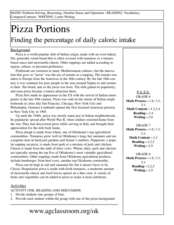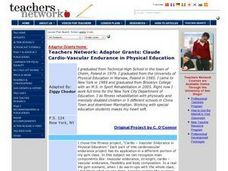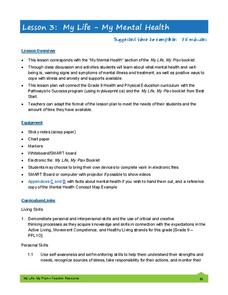DocsTeach
Uncle Sam and the American Diet
Uncle Sam wants you to follow the food pyramid! Scholars analyze two images of propaganda posters the government created to promote the food pyramid. Academics complete a worksheet to understand the impact of the campaign and end the...
Curated OER
Calcium -bonebuilders
Students demonstrate their understanding of a body's need for calcium by constructing healthy diet habits with calcium rich food.
Curated OER
Food and Your Body -- How to Maintain a Healthy Diet
Middle schoolers examine the different food groups on the food pyramid. In groups, they discover the proper amount to eat from each food group and how to prepare healthy meals. They keep a food journal and calculate the amount of...
Curated OER
Fatty Food
Students view various types of food that are listed as bad for all people. Students chart out all findings within this lesson. Students talk in an open forum of ways they could change their eating habits in the future.
Curated OER
Pizza Portions
Students explore mathematics by participating in a pizza pie activity. In this nutrition lesson, students identify the caloric intake in a piece of pizza and estimate the average number of slices eaten by a person. Students utilize...
Curated OER
Feature Column: Virtual Field Trips
Students discover ways to stay healthy by utilizing Internet education software. In this computer technology lesson, students investigate Internet programs that simulate a field trip by showing images and video. Students...
Curated OER
Soda to be Absent from Schools
Should schools serve soda to students? Learners read an artlcle that argues against the sale of soda in schools and engage in a class discussion. They then complete a short assessment to check for comprehension and reflect on the...
Curated OER
Obesity, Eating Habits and Weight Loss
Students conduct Internet research, view film and participate in class discussion to identify the problem and causes of obesity in America. They evaluate the food pyramid and break down the nutritional components of fast food and frozen...
Curated OER
The Quicker the Better? Food Processing
Sixth graders explore food processing. For this food processing lesson, 6th graders investigate the effects of processing foods on the food's nutritional value. Students examine a variety of healthy snack options.
California Department of Public Health
Walking on the Path to Better Health
Walk your way to health with this great resource! Walking is a valuable physical activity that can be done frequently and with ease by learners of all ages. "Warm up" by reviewing the benefits of physical activity with your class...
Curated OER
Weight Control
Middle schoolers study the importance of a healthy diet. In this weight control lesson students divide into groups and develop a healthy lunch menu.
Curated OER
Cardio-Vascular Endurance
Students in a special education class work to improve their endurance. As a class, they complete the same exercises at the beginning of each class trying to increase the number of reps. They are also introduced to healthy eating habits...
Hastings Prince Edward Public Health
What is Health?
Many indicators of health are beyond a teenager's control, but there are many changes they can make in their daily life that can improve their health. Middle schoolers think about their physical, social, and mental health status before...
Hastings Prince Edward Public Health
My Life—My Mental Health
Between peer pressure, an onslaught of hormones, and brand new responsibilities, the teenage years can be emotionally volatile. Equip young adults with coping mechanisms and a safe place to discuss their feelings with a guided...
Curated OER
Human Body Series: Sleep
In this sleep habits worksheet, students fill out a log for one week that details sleep habits and patterns including hours slept, naps, and the energy level felt each day.
Curated OER
Get Fit for Yosemite - Nutrition
Students demonstrate an understanding of healthy eating habits and of following a fitness program. They visit Yosemite Institute.
Baylor College
Body Mass Index (BMI)
How do you calculate your Body Mass Index, and why is this information a valuable indicator of health? Class members discover not only what BMI is and practice calculating it using the height and weight of six fictitious individuals, but...
Nemours KidsHealth
Food Allergies: Grades 6-8
Over two lessons, scholars use articles and discussions to define what a food allergy is and identify the most common food allergens. Small groups prepare a skit showcasing how the body exhibits an allergic reaction. Learners examine...
Nemours KidsHealth
Diabetes: Grades 6-8
After reading a series of articles that provide background information about Type 1 and Type 2 diabetes, class members design a meal plan and an activity plan for a weeklong summer camp for 5- to 8-year olds with diabetes. A second...
Nemours KidsHealth
Cold and Flu: Grades 6-8
Wouldn't it be lovely if people were immune from colds and flu? Alas, such is not the case; however, there are things we can do to avoid getting or spreading these pesky health hazards. Middle schoolers read articles that provide them...
Curated OER
Nutrition and Physical Education Activities in the Classroom
You can promote health and wellness using nutrition activities and lessons. With physical education activities and suggestions about snack times, you can help impvove the habits of the youngsters under your charge.
Curated OER
Junk Food Jungle
Students become familiar with the nutritional value of foods advertised on television and in magazines. They discuss different types of foods and where snack food fits into a healthy diet. They categorize the foods they eat as healthy or...
Curated OER
Ratios, Rates, Percent and Nutrition
Examine food labels to determine percentage of fat and sugar to total calories with middle schoolers. Daily nutritional guidelines are discussed and learners will decide how well their foods fit into a healthy diet. In the provided...
Curated OER
Food, Meals, and Cooking
Students examine the eating habits of people in other countries and learn new vocabulary. They also practice using nouns and the passive voice.























